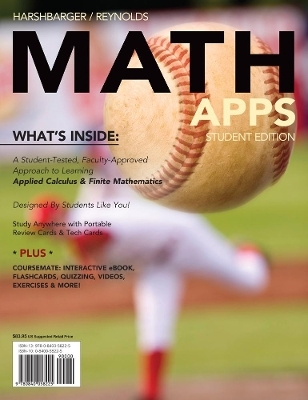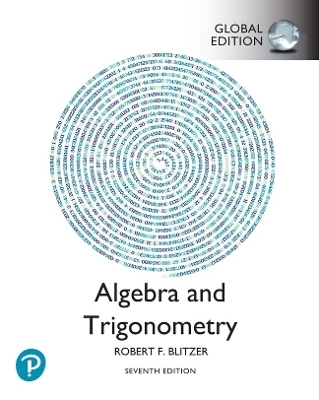
MATH APPS (with Math CourseMate with eBook Printed Access Card)
Brooks/Cole
978-0-8400-5822-5 (ISBN)
- Titel ist leider vergriffen;
keine Neuauflage - Artikel merken
Created through a "student-tested, faculty-approved" review process, MATH APPS is an engaging and accessible solution to accommodate the diverse lifestyles of today's learners at a value-based price. The book's concept-based approach, multiple presentation methods, and interesting and relevant applications keep students who typically take the course—business, economics, life sciences, and social sciences majors—engaged in the material. An innovative combination of content delivery both in print and online provides a core text and a wealth of comprehensive multimedia teaching and learning assets, including end-of-chapter review cards, downloadable flashcards and practice problems, online video tutorials, solutions to exercises aimed at supplementing learning outside of the classroom.
Attention CourseMate user: The CourseMate platform is being sunset and will not be sold with this title after December 31st, 2019. Cengage will support existing users of CourseMate through August 1st, 2020.
A professor at the University of South Carolina, Ron Harshbarger has worked with Jim Reynolds on MATHEMATICAL APPLICATIONS since the book's inception. Like his co-author, he has taught for over 20 years, at all levels of undergraduate mathematics.
1. Linear Equations and Functions.
1.1. Solutions of Linear Equations and Inequalities in One Variable.
Equations.
Linear Inequalities.
1.2. Functions.
Relations and Functions.
Graphs of Functions.
Function Notation.
Domains and Ranges.
Operations with Functions.
1.3. Linear Functions.
Intercepts.
Rate of Change; Slope of a Line.
Writing Equations of Lines.
1.4. Solutions of Systems of Linear Equations.
Graphical Solution.
Solution by Substitution.
Solution by Elimination.
Three Equations in Three Variables.
1.5. Applications of Functions in Business and Economics.
Total Cost, Total Revenue, and Profit.
Break-Even Analysis.
Supply, Demand, and Market Equilibrium.
Supply, Demand, and Taxation.
Chapter Exercises.
2. Quadratic and Other Special Functions.
2.1. Quadratic Equations.
Factoring Methods.
The Quadratic Formula.
2.2Quadratic Functions: Parabolas.
Parabolas.
2.3. Business Applications of Quadratic Functions.
Supply, Demand, and Market Equilibrium.
Break-Even Points and Maximization.
2.4. Special Functions and Their Graphs.
Basic Functions.
Polynomial and Rational Functions.
Piecewise Defined Functions.
2.5. Modeling Data with Graphing Utilities (optional).
Chapter Exercises.
Chapter 3Matrices.
3.1. Operations with Matrices.
Addition and Subtraction of Matrices.
Scalar Multiplication.
3.2. Multiplication of Matrices.
Product of Two Matrices.
3.3. Gauss-Jordan Elimination: Solving Systems of Equations.
Systems with Unique Solutions.
Systems with Nonunique Solutions.
Nonsquare Systems.
3.4. Inverse of a Square Matrix.
Matrix Equations.
Determinants.
Chapter Exercises.
4. Inequalities and Linear Programming.
4.1 Linear Inequalities in Two Variables.
One Linear Inequality in Two Variables.
Systems of Linear Inequalities.
4.2. Linear Programming: Graphical Methods.
Solving Graphically.
4.3. The Simplex Method: Maximization.
The Simplex Method.
Tasks and Procedure.
Nonunique Solutions: Multiple Solutions and No Solution.
4.4. The Simplex Method: Duality and Minimization.
Dual Problems.
Duality and Solving.
4.5. The Simplex Method with Mixed Constraints.
Mixed Constraints and Maximization.
Mixed Constraints and Minimization.
Chapter Exercises.
5. Exponential and Logarithmic Functions.
5.1. Exponential Functions.
Modeling with Exponential Functions.
5.2. Logarithmic Functions and Their Properties.
Logarithmic Functions and Graphs.
Modeling with Logarithmic Functions.
Properties of Logarithms.
Change of Base.
5.3. Applications of Exponential and Logarithmic Functions.
Solving Exponential Equations Using Logarithmic.
Properties.
Growth and Decay.
Economic and Management Applications.
Chapter Exercises.
6. Mathematics of Finance.
6.1. Simple Interest and Arithmetic Sequences.
Future Value.
Arithmetic Sequences.
6.2Compound Interest and Geometric Sequences.
Compound Interest.
Geometric Sequences.
6.3. Future Values of Annuities.
Ordinary Annuities.
Annuities Due.
6.4. Present Values of Annuities.
Ordinary Annuities.
Annuities Due.
Deferred Annuities.
6.5. Loans and Amortization.
Amortization.
Unpaid Balance of a Loan.
Chapter Exercises.
7. Introduction to Probability.
7.1. Probability and Odds.
Sample Spaces and Single Events.
Empirical Probability.
Odds.
7.2. Unions, Intersections, and Complements of Events.
Inclusion-Exclusion Principle.
7.3. Conditional Probability: The Product Rule.
7.4. Probability Trees and Bayes' Formula.
Probability Trees.
Bayes' Formula.
7.5. Counting: Permutations and Combinations.
Permutations.
Combinations.
7.6. Permutations, Combinations, and Probability.
Chapter Exercises.
8. Probability and Data Description.
8.1. Binomial Probability Experiments.
8.2. Describing Data.
Statistical Graphs.
Types of Averages.
Variance and Standard Deviation.
8.3. Discrete Probability Distributions.
Discrete Probability Distributions.
Measures of Dispersion.
The Binomial Distribution.
Binomial Formula.
8.4. Normal Probability Distribution.
z-Scores.
Chapter Exercises.
9. Derivatives.
9.1. Limits.
Notion of a Limit.
Properties of Limits, Algebraic Evaluation.
Limits of Piecewise Defined Functions.
9.2. Continuous Functions; Limits at Infinity.
Continuous Functions.
Limits at Infinity.
9.3. Average and Instantaneous Rates of Change: The Derivative.
Instantaneous Rates of Change: Velocity.
Tangent to a Curve.
Differentiability and Continuity.
9.4. Derivative Formulas.
Additional Formulas.
Marginal Revenue.
9.5. The Product Rule and the Quotient Rule.
Product Rule.
Quotient Rule.
9.6. The Chain Rule and the Power Rule.
Chain Rule.
Power Rule.
9.7. Using Derivative Formulas.
9.8. Higher-Order Derivatives.
Second Derivatives.
Higher-Order Derivatives.
9.9. Derivatives in Business and Economics.
Marginal Revenue.
Marginal Cost.
Marginal Profit.
Chapter Exercises.
10. Applications of Derivatives.
10.1. Relative Maxima and Minima: Curve Sketching.
10.2. Concavity: Points of Inflection.
Points of Inflection.
Second-Derivative Test.
10.3. Optimization in Business and Economics.
Absolute Extrema.
Maximizing Revenue.
Minimizing Average Cost.
Maximizing Profit.
10.4. Applications of Maxima and Minima.
10.5. Rational Functions: More Curve Sketching.
Asymptotes.
More Curve Sketching.
Chapter Exercises.
11. Derivatives Continued.
11.1. Derivatives of Logarithmic Functions.
Using Properties of Logarithms.
11.2. Derivatives of Exponential Functions.
11.3. Implicit Differentiation.
11.4. Related Rates.
Percent Rates of Change.
Solving Related-Rates Problems.
11.5. Applications in Business and Economics.
Elasticity of Demand.
Taxation in a Competitive Market.
Chapter Exercises.
12. Indefinite Integrals.
12.1. The Indefinite Integral.
12.2. The Power Rule.
12.3. Integrals Involving Exponential and Logarithmic Functions.
Integrals Involving Exponential Functions.
Integrals Involving Logarithmic Functions.
12.4. The Indefinite Integral in Business and Economics.
Total Cost and Profit.
National Consumption and Savings.
12.5. Differential Equations.
Solution of Differential Equations.
Separable Differential Equations.
Applications of Differential Equations.
Chapter Exercises.
13. Definite Integrals: Techniques of Integration.
13.1. The Definite Integral: The Fundamental Theorem of Calculus.
Estimating the Area under a Curve.
13.2. Area between Two Curves.
13.3. Definite Integrals in Business and Economics.
Continuous Income Streams.
Consumer's Surplus.
Producer's Surplus.
13.4. Using Tables of Integrals.
13.5. Integration by Parts.
13.6. Improper Integrals and Their Applications.
Chapter Exercises.
14. Functions of Two or More Variables.
14.1. Functions of Two or More Variables.
14.2. Partial Differentiation.
First-Order Partial Derivatives.
Higher-Order Partial Derivatives.
14.3. Functions of Two Variables in Business and Economics.
Joint Cost and Marginal Cost.
Production Functions.
Demand Functions.
14.4. Maxima and Minima.
14.5. Constrained Optimization and Lagrange Multipliers.
Chapter Exercises.
Answers to Odd-Numbered Exercises.
Index.
| Verlagsort | CA |
|---|---|
| Sprache | englisch |
| Maße | 213 x 271 mm |
| Gewicht | 930 g |
| Themenwelt | Mathematik / Informatik ► Mathematik ► Algebra |
| Mathematik / Informatik ► Mathematik ► Angewandte Mathematik | |
| Schlagworte | Mathematik |
| ISBN-10 | 0-8400-5822-5 / 0840058225 |
| ISBN-13 | 978-0-8400-5822-5 / 9780840058225 |
| Zustand | Neuware |
| Haben Sie eine Frage zum Produkt? |
aus dem Bereich

